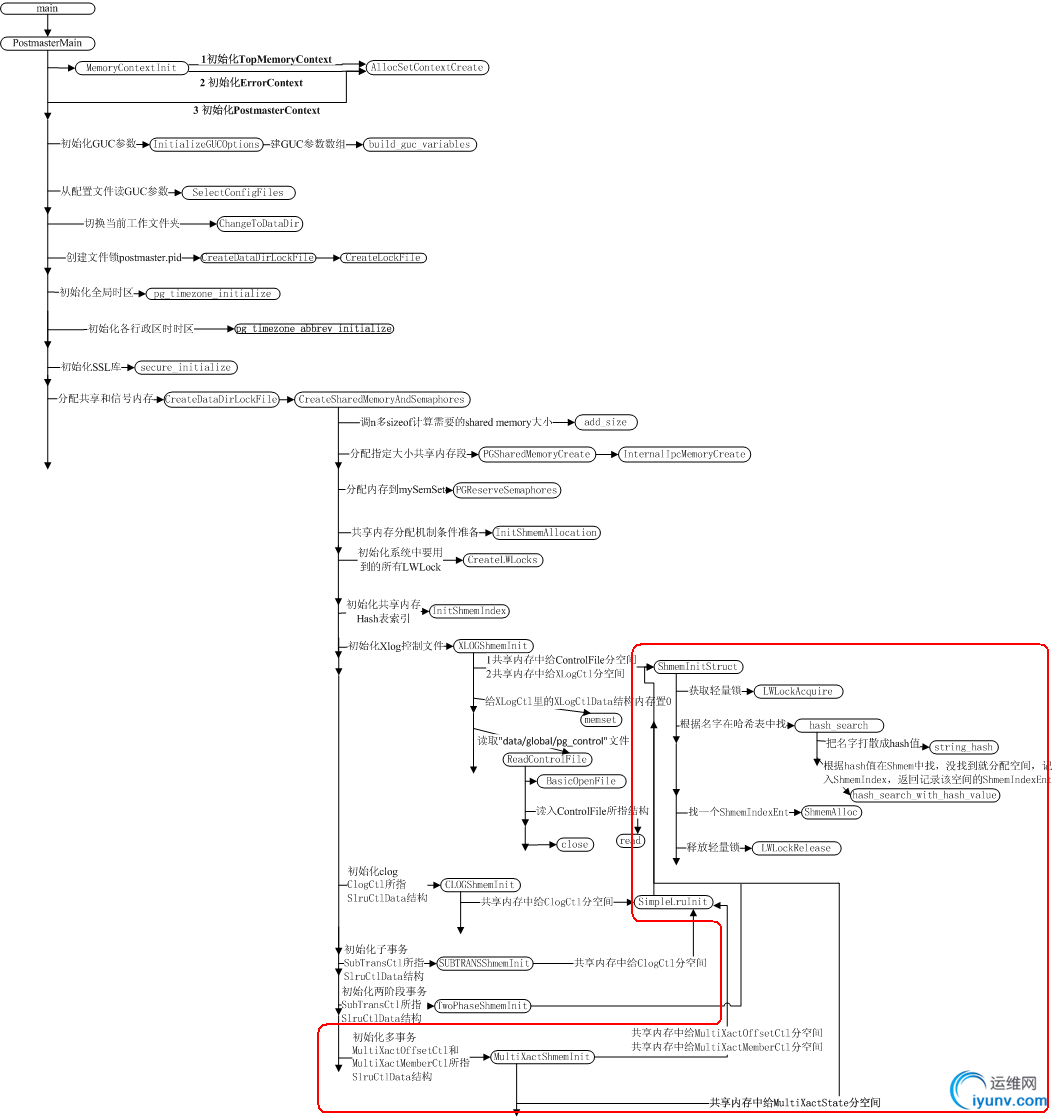pg初始化shmem,给其加上索引"ShmemIndex"后,接着就在shmem里初始化xlog。然后依次初始化clog、subtrans、twophase、multixact。安排按clog、subtrans、multixact、twophase的顺序写,把twophase放到multixact之后是因为前面三个用了相同的算法和数据结构,连起来写可以加深印象和归类记忆,本来想把初始化clog、subtrans、multixact放到一篇文章里写,因为篇幅太长还是分开了,看的时候这几篇文章可以结合起来看。
pg多事务日志管理器是一个类pg提交事务管理器,为每一个MultiXactId存事务ID数组。它是共享行锁(shared-row-lock)实现的一个基础部分。一个被共享锁锁住的元组把MultiXactId存在自己的Xmax字段里,且一个事务需要等待元组被解锁后才能睡眠/再加锁于可能由多个事务ID组成的该MultiXactId之上。
Pg使用两套SLRU相关结构,一套存放偏移量,这个偏移量是在另一套SLRU相关结构里每一个MultiXactId数据的开始位置。这样的设计可以使我们保存变长事务ID数组。
和XLOG的关系:当一个新的偏移量或者成员页面被初始化为0时,MultiXact模块产生一个XLOG记录,以及定义一个新的MultiXactId时,也会产生一个XLOG记录。这样使pg可以在重做事务日志(XLOG replay)时完整重建进入的数据。因为这一点,pg不必遵循“在写数据前写WAL日志”的一般原则;只需要正确的保证在checkpoint完成之前我们把脏OFFSET和MEMBER页面(上面提到的两套SLRU相关结构的页面)刷出和同步到磁盘。在相应的WAL日志记录之前,如果一个页面做了,在使用该页面之前,这个页面肯定会被强制归0。因此,pg不需要用LSN信息标记内存页面;pg已经有了足够的同步。
像事务提交日志(CLOG)一样,但不像子事务(subtrans),pg必须保存跨越崩溃/崩溃恢复的状态且保证MultiXactId和偏移量数字在跨越破溃/破溃恢复时单调增长。Pg用和事务ID同样的方式保证这一点:WAL日志记录保证包含每一个MXID的证据,我们不要担心这个,我们只需要确保在恢复时重放事务日志结束的时候,下一个MXID和下一个偏移量计数器至少是在重放日志中相应最大的就可以了。
上面概述了MultiXact,下来我们看方法调用流程
1先上个图,看一下函数调用过程梗概,中间略过部分细节

初始化MultiXact方法调用流程图
2初始化xlog相关结构
话说main()->…->PostmasterMain()->…->reset_shared()-> CreateSharedMemoryAndSemaphores()->…-> MultiXactShmemInit(),初始化MultiXact事务相关数据结构MultiXactOffsetCtl、MultiXactMemberCtl、MultiXactState等,用作内存里管理和缓存MultiXact事务日志文件(存放在"data/pg_multixact/offsets"和"data/pg_multixact/members"文件夹里的文件)。
MultiXactShmemInit ()->SimpleLruInit()->ShmemInitStruct(),在其中调用hash_search()在哈希表索引"ShmemIndex"中查找" MultiXactOffset Ctl",如果没有,就在shmemIndex中给" MultiXactOffset Ctl "分一个HashElement和ShmemIndexEnt(entry),在其中的Entry中写上"MultiXactOffset Ctl"。返回ShmemInitStruct(),再调用ShmemAlloc()在共享内存上给" MultiXactOffset Ctl"相关结构(见下面“MultiXact相关结构图”)分配空间,设置entry(在这儿及ShmemIndexEnt类型变量)的成员location指向该空间,size成员记录该空间大小,最后返回MultiXactShmemInit (),让SlruCtlData *类型全局变量MultiXactOffsetCtl指向SlruCtlData 类型静态全局变量MultiXactOffsetCtlData,MultiXactOffsetCtlData的起始地址就是在shmem里给"MultiXactOffset Ctl"相关结构分配的内存起始地址,设置其中SubTransCtlData结构类型的成员值。
接着MultiXactShmemInit ()->SimpleLruInit()->ShmemInitStruct(),在其中调用hash_search()在哈希表索引"ShmemIndex"中查找"MultiXactMember Ctl",如果没有,就在shmemIndex中给"MultiXactMember Ctl "分一个HashElement和ShmemIndexEnt(entry),在其中的Entry中写上"MultiXactMember Ctl"。返回ShmemInitStruct(),再调用ShmemAlloc()在共享内存上给"MultiXactMember Ctl"相关结构(见下面“MultiXact相关结构图”)分配空间,设置entry(在这儿及ShmemIndexEnt类型变量)的成员location指向该空间,size成员记录该空间大小,最后返回MultiXactShmemInit (),让SlruCtlData *类型全局变量MultiXactMemberCtl指向SlruCtlData 类型静态全局变量MultiXactMemberCtlData,MultiXactMemberCtlData的起始地址就是在shmem里给"MultiXactMember Ctl"相关结构分配的内存起始地址,设置其中SubTransCtlData结构类型的成员值。
然后调用ShmemInitStruct(),在其中调用hash_search()在哈希表索引"ShmemIndex"中查找"Shared MultiXact State",如果没有,就在shmemIndex中给" Shared MultiXact State"分一个HashElement和ShmemIndexEnt(entry),在其中的Entry中写上"Shared MultiXact State"。返回ShmemInitStruct(),再调用ShmemAlloc()在共享内存上给"Shared MultiXact State"相关结构(见下面“MultiXact相关结构图”)分配空间,设置entry(在这儿及ShmemIndexEnt类型变量)的成员location指向该空间,size成员记录该空间大小,最后返回MultiXactShmemInit (),让MultiXactStateData *类型全局静态变量MultiXactState指向MultiXactStateData结构实例,MultiXactStateData的起始地址就是在shmem里给"Shared MultiXact State"相关结构分配的内存起始地址,设置其中MultiXactStateData结构类型的成员值。
相关变量、结构定义和初始化完成后数据结构图在下面。
static MT_LOCAL SlruCtlData MultiXactOffsetCtlData;
static MT_LOCAL SlruCtlData MultiXactMemberCtlData;
#define MultiXactOffsetCtl (&MultiXactOffsetCtlData)
#define MultiXactMemberCtl (&MultiXactMemberCtlData)
typedef structSlruCtlData
{
SlruShared shared;
/*
* This flag tells whether to fsync writes(true for pg_clog, false for
* pg_subtrans).
*/
bool do_fsync;
/*
* Decide which of two page numbers is"older" for truncation purposes. We
* need to use comparison of TransactionIdshere in order to do the right
* thing with wraparound XID arithmetic.
*/
bool (*PagePrecedes)(int, int);
/*
* Dir is set during SimpleLruInit and does notchange thereafter. Since
* it's always the same, it doesn't need to bein shared memory.
*/
char Dir[64];
} SlruCtlData;
typedef SlruCtlData *SlruCtl;
/*
* Shared-memorystate
*/
typedef structSlruSharedData
{
LWLockId ControlLock;
/* Number of buffers managed by this SLRU structure */
int num_slots;
/*
* Arrays holding info for each bufferslot. Page number is undefined
* when status is EMPTY, as is page_lru_count.
*/
char **page_buffer;
SlruPageStatus*page_status;
bool *page_dirty;
int *page_number;
int *page_lru_count;
LWLockId *buffer_locks;
/*----------
* We mark a page "most recentlyused" by setting
* page_lru_count[slotno]= ++cur_lru_count;
* The oldest page is therefore the one withthe highest value of
* cur_lru_count- page_lru_count[slotno]
* The counts will eventually wrap around, butthis calculation still
* works as long as no page's age exceedsINT_MAX counts.
*----------
*/
int cur_lru_count;
/*
* latest_page_number is the page number of thecurrent end of the log;
* this is not critical data, since we use itonly to avoid swapping out
* the latest page.
*/
int latest_page_number;
} SlruSharedData;
typedef SlruSharedData *SlruShared;
static MultiXactStateData *MultiXactState;
typedef structMultiXactStateData
{
/* next-to-be-assigned MultiXactId */
MultiXactIdnextMXact;
/* next-to-be-assigned offset */
MultiXactOffsetnextOffset;
/* the Offset SLRU area was last truncated at thisMultiXactId */
MultiXactIdlastTruncationPoint;
/*
* Per-backend data starts here. We have two arrays stored in the area
* immediately following the MultiXactStateDatastruct. Each is indexed by
* BackendId. (Note: valid BackendIds run from 1 to MaxBackends; element
* zero of each array is never used.)
*
* OldestMemberMXactId[k] is the oldestMultiXactId each backend's current
* transaction(s) could possibly be a memberof, or InvalidMultiXactId
* when the backend has no live transactionthat could possibly be a
* member of a MultiXact. Each backend sets its entry to the current
* nextMXact counter just before firstacquiring a shared lock in a given
* transaction, and clears it at transactionend. (This works because only
* during or after acquiring a shared lockcould an XID possibly become a
* member of a MultiXact, and that MultiXactwould have to be created
* during or after the lock acquisition.)
*
* OldestVisibleMXactId[k] is the oldestMultiXactId each backend's
* current transaction(s) think is potentiallylive, or InvalidMultiXactId
* when not in a transaction or not in atransaction that's paid any
* attention to MultiXacts yet. This is computed when first needed in a
* given transaction, and cleared attransaction end. We can compute it
* as the minimum of the validOldestMemberMXactId[] entries at the time
* we compute it (using nextMXact if none arevalid). Each backend is
* required not to attempt to access any SLRUdata for MultiXactIds older
* than its own OldestVisibleMXactId[] setting;this is necessary because
* the checkpointer could truncate away suchdata at any instant.
*
* The checkpointer can compute the safetruncation point as the oldest
* valid value among all theOldestMemberMXactId[] and
* OldestVisibleMXactId[] entries, or nextMXactif none are valid.
* Clearly, it is not possible for anylater-computed OldestVisibleMXactId
* value to be older than this, and so there isno risk of truncating data
* that is still needed.
*/
MultiXactIdperBackendXactIds[1]; /* VARIABLE LENGTH ARRAY */
} MultiXactStateData;
下面看看初始化完"MultiXactOffset Ctl"、"MultiXactOffset Ctl"及"Shared MultiXact State"相关结构后在内存中的结构图
初始化完MultiXact相关结构的内存结构图
为了精简上图,把创建shmem的哈希表索引"ShmemIndex"时创建的HCTL结构删掉了,这个结构的作用是记录创建可扩展哈希表的相关信息。增加了左边灰色底的部分,描述共享内存/shmem里各变量物理布局概览,由下往上,由低地址到高地址。其中的"MultiXactCtl"相关机构即MultiXactOffsetCtl和MultiXactMemberCtl的相关结构图下面分别给出,要不上面的图太大太复杂了。
MultiXact相关结构图
|